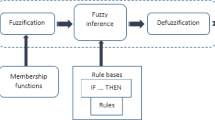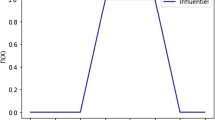Abstract
Social media becomes a part of our lives. People use different form of it to express their opinions on variety of ideas, events and facts. Twitter, as an example of such media, is commonly used to post short messages—tweets—related to variety of subjects. The paper proposes on application of fuzzy-based methodologies to process tweets, and to interpret information extracted from those tweets. We state that the obtained knowledge is fully explored and better comprehend when fuzziness is used. In particular, we analyze hashtags and keywords to extract useful knowledge. We look at the popularity of hashtags and changes of their popularity over time. Further, we process hashtags and keywords to build fuzzy signatures representing concepts associated with tweets.
Access this chapter
Tax calculation will be finalised at checkout
Purchases are for personal use only
Similar content being viewed by others
References
https://twitter.com/. Accessed 8th May 2015
L.A. Zadeh, Fuzzy sets. Inf. Control 8, 338–353 (1965)
http://dictionary.reference.com. Accessed 8th May 2015
http://www.wikipedia.org. Accessed 8th May 2015
G. Klir, B. Yuan, Fuzzy Sets and Fuzzy Logic: Theory and Applications, (Prentice Hall, 1995)
W. Pedrycz, F. Gomide, Fuzzy Systems Engineering: Toward Human-Centric Computing, (Wiley-IEEE Press, 2007)
A. Chaturvedi, P. Green, J. Carroll, K-modes clustering. J. Classif. 18(1), 35–55 (2001)
A.K. Jain, M.N. Murty, P.J. Flynn, Data clustering: a review. ACM Comput. Surv. 31(3), 264–323 (1999)
A.K. Jani, Data clustering: 50 years beyond K-means. Pattern Recogn. Lett. 31(8), 651–666 (2010)
K.L. Wu, M.S. Yang, Alternative c-means clustering algorithms. Pattern Recogn. 35, 2267–2278 (2002)
A. Baraldi, P. Blonda, A survey of fuzzy clustering algorithms for pattern recognition. IEEE Trans. Syst Man, Cybern. Part B Cybern. 29(6), 778–785 (1999)
J.C. Bezdek, Pattern Recognition with Fuzzy Objective Function Algorithms (Plenum Press, New York, 1981)
Z.X. Huang, M.K. Ng, A fuzzy k-modes algorithm for clustering categorical data. IEEE Trans. Fuzzy Syst. 7(4), 446–452 (1999)
L. Kaufman, P.J. Rousseeuw, Finding Groups in Data: An Introduction to Cluster Analysis (Wiley, New York, 1990)
http://www.r-project.org. Accessed 8th May 2015
P.J. Rousseeuw, Silhouettes: a graphical aid to the interpretation and validation of cluster analysis. J. Comput. Appl. Math. 20, 53–65 (1987)
G. Pison, A. Struyf, P.J. Rousseeuw, Displaying a clustering with CLUSPLOT. Comput. Stat. Data Anal. 30, 381–392 (1999)
L.T. Jolliffe, Principal Component Analysis, 2nd edn. (Springer, Berlin, 2002)
M.Z. Reformat, R.R. Yager, in Using Tagging in Social Networks to Find Groups of Compatible Users, 2013 IFSA-NAFIPS Join Congress, Edmonton, Canada, 24–28 June 2013
R.R. Yager, M.Z. Reformat, Looking for like-minded individuals in social networks using tagging and fuzzy sets. IEEE Trans. Fuzzy Syst. 21(4), 672–687 (2013)
A. Pal, B. Mondal, N. Bhattacharyya, S. Raha, Similarity in fuzzy systems. J. Uncertainty Anal. Appl. 2(1) (2014)
C.P. Pappis, N.I. Karacapilidis, A comparative assessment of measures of similarity of fuzzy values. Fuzzy Sets Syst. 56(2), 171–174 (1993)
T. Gerstenkorn, J. Manko, Correlation of intuitionistic fuzzy sets. Fuzzy Sets Syst. 44(1), 39–43 (1991)
K.T. Atanassov, Intuitionistic fuzzy sets. Fuzzy Sets Syst. 20(1), 87–96 (1986)
D. Dumitrescu, A definition of an informational energy in fuzzy sets theory. Stud. Univ. Babes-Bolyai Math. 22(2), 57–59 (1977)
D. Dumitrescu, Fuzzy correlation. Studia Univ. Babes-Bolyai Math. 23, 41–44 (1978)
F.Y. Cao, J.Y. Liang, L. Bai et al., A framework for clustering categorical time-evolving data. IEEE Trans. Fuzzy Syst. 18(5), 872–882 (2010)
S.N. Shahbazova, Development of the knowledge base learning system for distance education. Int. J. Intell. Syst. 27(4), 343–354 (2012)
S.N. Shahbazova, Application of fuzzy sets for control of student knowledge, Appl. Comput. Math. Int. J. 10(1), 195–208 (2011). ISSN 1683–3511. (Special issue on fuzzy set theory and applications)
O. Koshelova, S.N. Shahbazova, “Fuzzy” multiple-choice quizzes and how to grade them. J. Uncertain Syst. 8(3), 216–221 (2014). Online at: www.jus.org.uk
A.M. Abbasov, S.N. Shahbazova, Informational modeling of the behavior of a teacher in the learning process based on fuzzy logic. Int. J. Intell. Syst. 31(1), 3–18 (2015)
S. N. Shahbazova, Modeling of creation of the complex on intelligent information systems learning and knowledge control (IISLKC). Int. J. Intell. Syst. 29(4), 307–319 (2014)
L.A. Zadeh, A.M. Abbasov, S.N. Shahbazova, Fuzzy-based techniques in human-like processing of social network data. Int. J. Uncertainty, Fuzziness Knowl. Based Syst. 23(1), 1–14 (2015)
Author information
Authors and Affiliations
Corresponding author
Editor information
Editors and Affiliations
Rights and permissions
Copyright information
© 2020 Springer Nature Switzerland AG
About this chapter
Cite this chapter
Shahbazova, S.N. (2020). Fuzziness in Information Extracted from Tweets’ Hashtags and Keywords. In: Shahbazova, S., Sugeno, M., Kacprzyk, J. (eds) Recent Developments in Fuzzy Logic and Fuzzy Sets. Studies in Fuzziness and Soft Computing, vol 391. Springer, Cham. https://doi.org/10.1007/978-3-030-38893-5_1
Download citation
DOI: https://doi.org/10.1007/978-3-030-38893-5_1
Published:
Publisher Name: Springer, Cham
Print ISBN: 978-3-030-38892-8
Online ISBN: 978-3-030-38893-5
eBook Packages: Intelligent Technologies and RoboticsIntelligent Technologies and Robotics (R0)




